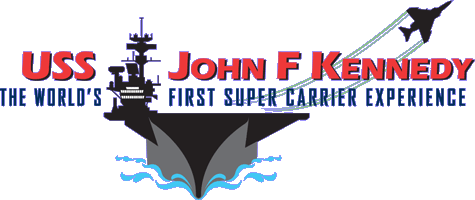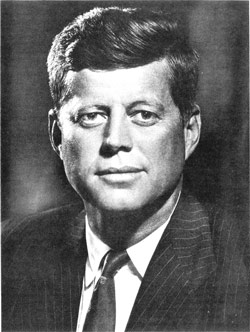 John Fitzgerald Kennedy, the 35th President of the United States, was born on 29 May 1917 in Brookline, Massachusetts, and graduated cum laude from Harvard University in 1940. He served in the U.S. Naval Reserve from October 1941until he was retired from active duty due to disability on 1 March 1945.
John Fitzgerald Kennedy, the 35th President of the United States, was born on 29 May 1917 in Brookline, Massachusetts, and graduated cum laude from Harvard University in 1940. He served in the U.S. Naval Reserve from October 1941until he was retired from active duty due to disability on 1 March 1945.
Having assumed the family’s political mantle after the end of World War II, his older brother Joseph P. Kennedy, Jr., having been killed during the war, Kennedy was elected to the 80th U.S. Congress on 5 November 1946, and was elected twice more, to the 81st and 82d Congresses. Elected Senator on 4 November 1952, and re-elected 4 November 1958, he focused on national defense and civil rights issues. Kennedy ran for President against Republican Richard M. Nixon and won the contest, being elected to the presidency on 8 November 1960.
In his inaugural address of 20 January 1961, Kennedy advocated that “the word go forth from this time and place to friend and foe alike, that the torch has passed to a new generation of Americans—born in this century, tempered by war, disciplined by a hard and bitter peace, proud of our ancient heritage.” As President, he prepared legislation and mobilized the strength of the Federal Government to insure minorities the benefits of American society. He also sought sweeping reforms in fields of economic welfare, health, and education: “… every American has the right to a decent life for himself and a better life for his children.”
In the context of the Cold War, Kennedy wisely used sea power to meet global crises during the ideological struggle with the Soviet Union, including a “quarantine” of Cuba in the autumn of 1962 that choked off the flow of military supplies to that island and persuaded the Soviet Union to remove its offensive missiles. Speaking from the flight deck of the attack carrier Kitty Hawk (CVA-63) on 6 June 1963, he recalled the role of American sea power during that confrontation: “Events of October 1962 indicated, as they had all through history, that control of the sea means security. Control of the seas can mean peace. The United States must control the seas if it is to protect your security and those countries which stretch thousands of miles away that look to you on this ship and the sister ships of the United States Navy.”
He was dedicated to his belief “that all the world—in Eastern Europe as well as Western, in Southern Africa as well as Northern, in old nations as well as new—that people must be free to choose their own future, without discrimination or dictation, without coercion or subversion.” In hopes of spreading American ideals to the developing world, Kennedy created the Peace Corps and supported reform and democratization in Latin America and Africa.
As Soviet threats to Berlin flared anew in the summer of 1963, he visited West Berlin. “Freedom is indivisible,” he declared there, “and when one man is enslaved, all are not free.” Worries over the Soviet threat to Western Europe also encouraged Kennedy to act forcefully in Southeast Asia, and he sent thousands of advisors to advise the South Vietnamese military.
Despite a major escalation of the ballistic missile arms race with the Soviet Union that began under his administration, Kennedy did manage to use the Cuban missile crisis to tone down the rhetoric of the Cold War. The sobering experience also encouraged the nuclear powers to sign the 1963 treaty outlawing atmospheric or underwater nuclear tests, an achievement called “the first concrete limitation on the nuclear arms race since the bomb was invented.”
Tragically, on 22 November 1963, as his motorcade traveled through downtown Dallas, Texas, Kennedy, as well as Texas Governor John Connally, riding in the same automobile, were felled by assassin’s bullets. Police arrested Lee Harvey Oswald, who had been seen in the nearby Texas Schoolbook Depository building, later that day. While Connally survived the attack, the President was pronounced dead at Parkland Hospital in Dallas a short time later. He was interred on 25 November 1963 in Arlington National Cemetery, the sight of his son John, Jr., saluting his slain father an indelible image as the nation mourned. – Courtesy Naval Historical Center
J.F.K.’s Naval Service
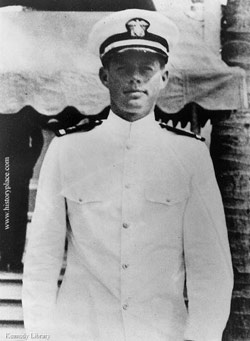
John Fitzgerald Kennedy, the 35th President of the United States, received an ensign’s commission in the U.S. Naval Reserve in October 1941.
He served in Washington in the Office of Naval Intelligence (October 1941-January 1942) and under Commandant, 6th Naval District, Charleston, South Carolina (January-July 1942), before he attended the U.S. Naval Reserve Midshipman’s School, Northwestern University, Chicago, Illinois (July-September 1942). Promoted to lieutenant (j.g.) on 1 October 1942, Kennedy underwent instruction at the Motor Torpedo Boat Squadrons (MTBRons) Training Center, Newport, Rhode Island (September-December 1942), Motor Torpedo Boat Squadron (MTBRon) 4 (December 1942-January 1943), where he was slated to command the motor torpedo boat PT-101, and then in the office of the Assistant Supervisor of Shipbuilding, Jacksonville, Florida (February 1943), in connection with fitting out MTBRon 14. Traveling to the Solomon Islands, Kennedy joined MTBRon 2, and ultimately assumed command of PT-109 on 24 April 1943, relieving Ensign Leonard J. Thom, USNR. The motor torpedo boat operated out of Tulagi, in the Solomons, and then Rendova.
During a patrol in Blackett Strait on the night of 1-2 August 1943, PT-109 was sunk
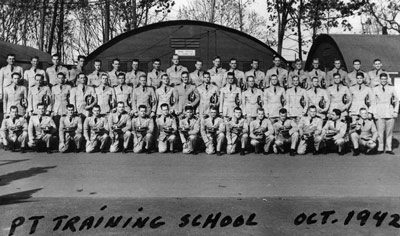
when the Japanese destroyer Amagiri (Lieutenant Commander Hanami Kouhei), rammed her and cut her in half. Kennedy directed the rescue efforts of the survivors of his crew, and rescued three, one of whom was the badly burned Motor Machinist’s Mate 2d Class Patrick H. McMahon, whom he personally towed back to the then-still floating wreckage of the forward part of the boat. Over the ensuing days, Kennedy managed to get his crew ashore. Ultimately, aided by friendly natives and a coastwatcher, PT-109’s surviving officers and men were rescued by PT-157 on 8 August 1943 and taken to Rendova.
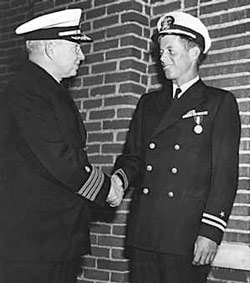
Following hospitalization in the aftermath of the loss of PT-109, during which time he received promotion to lieutenant (1 October 1943), Kennedy received further instruction at the MTBRons Training Center, Newport (December 1943-March 1944), and then the Subchaser Training Center, Miami, Florida (Mar-May 1944), where he received the Navy and Marine Corps Medal for the heroism he had displayed in the rescue of survivors from his sunken PT-boat. After suffering injuries in a fall, he underwent hospitalization at the U.S. Naval Hospital, Chelsea, Massachusetts (May 1944-March 1945), and, ultimately, retired from active duty on 1 March 1945.
All photos from the John F. Kennedy Presidential Library and Museum, Boston.
[button type=”simple_button_link” url=”https://www.ussjfkri.org/jfk-history-man-ship/president-kennedy/the-kennedy-ri-connection/” target=”” ]Next: The Kennedy-Rhode Island Connection[/button]
